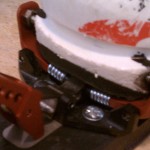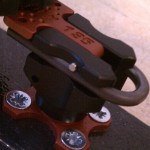The start was innocent. After half a decade of Diamir-induced excessive exertion, I sold my trusty heavy old-school boots for the Scarpa Matrix, and I finally bought a pair of Comforts to upgrade my BD Mira skis. Along with that came a pair of TLT IV/Tech/Classic/Speed bindings for, well, hmm, a discount etailer was selling – or rather, nearly giving away – the Atomic TM:11 rando race ski for around 80 bucks. Sure, why not? Well, because of what eventually ensued . . .
Over the years, I upgraded to the even lighter Atomic MX:20 skis, experimented with the Dynafit MLT4 boots, modified the Scarpa F1 race boot, and lightened up my Dynafit bindings a bit with some parts from B&D. Good enough. Or so I thought . . .
Last season I succumbed to Dynafit DyNA race boot temptation, not so much for use as a race boot but just because of its quickly acquired reputation as an outstanding touring boot. But still, with that boot in hand, or rather on foot, upgrading the rest of the setup and losing over a pound of weight was like an irresistible siren song, not so much for competition but because I have lots of local options for groomer skinning, while realistically my driving radius for seeking freshies is becoming more limited on account of my little proto skier (i.e., infant daughter).
For race bindings, the choices are numerous but the details on release capability seemed to be along the lines of don’t ask don’t tell (or is that don’t fall?) and availability in North America is limited (to put it mildly).
The new Trab race binding is now available in North America, yet lacks a ski crampon attachment point should I ever want to use my race setup for real touring.
The Dynafit race binding looks amazing but didn’t appear to be available yet. The older Dynafit race heel is now combined with the standard Speed toe for the Low Tech Light but the release values are still a complete unknown with widely varying impressions from various users.
The new ATK touring binding is being distributed in North America this season by the La Sportiva distributor, but only the RT binding, not the race binding.
I decided (eventually) upon the Plum race binding.
I went with the 135 model, which with screws weighs in at an actual 10.7 ounces, 303 grams (per pair!), plus 0.3 ounces for the optional ski crampon holder. The toe lever automatically goes into tour mode upon entry, but a new “safety device” retrofit will allow it to be skied in ski mode too. “Will allow” are the operative words however, since the date has been pushed back for that.
Mounting was (relatively) easy as one of my alpine downhill mounting jigs replicated the 20cm LeftRight heel unit hole pattern, the Plum website hosts a helpful mounting video, and Plum emailed me a heel template that I printed on transparency film. (Like all rando race bindings, the toe unit adheres to the back four holes of the Dynafit mounting pattern.) The toe pincers arrive unaffixed, allowing the pincer span to be dialed in exactly (although I just set it equal to my various Dynafit setups).
Plum stated (with various caveats) that the release values were the equivalent of 7 both lateral and forward (with 9 forward on the 145 model). The biggest caveat is that currently the toe unit can be skied only in “locked” mode, although the heel unit can be combined with a standard Dynafit toe.
Ski choices are also numerous although somewhat more straightforward since a ski is, well, just a ski, and the competition is very similar in terms of weight and dimensions.
The Trab Duo Race Aero has for many years been the baseline for comparison, and I can certainly understand how a slightly narrower and lighter version of my beloved Duo Sint Aero would be ideal. The Dynafit race ski has impressive specs.
Race skis are available from more mainstream ski companies Atomic, Dynastar, and Fischer yet oddly enough are not distributed in the U.S. By contrast, the U.S. company Goode has a race model. And I was very tempted by the Hagan X-Race.
But I eventually went with the Movement Fish, which weighs in at an actual 3 pounds 1.6 ounces in 162cm (although actually about 2cm longer than a 164cm Trab Duo Sint Aero). The tip has both a traditional hole along with a skin notch, which is cleverly offset at a significant angle to guard against loss of skin tip hardware.
So how does all this perform? For the ascent, the weight – or rather, lack thereof – is amazing, even compared to very lightweight touring-oriented setups. Taking full advantage of the set-up requires not just a big set of lungs but also some adjustment, since the possible stride length is so enormous, and the maximum cadence is very quick. Plus I keep needlessly starting to reach down upon binding entry to pull up on the toe lever — old habits take awhile to break…
For the descent, this of course is not exactly (or even inexactly) a quiver of one. But on consolidated snow, the setup performs astoundingly well. Deflection of course is always a concern with so little mass behind the various components (7 pounds 11.3 ounces, excluding footbeds and excluding the DyNA rubber I lost on various volcanoes last summer), but then again the lack of mass can help in some conditions and maneuvers too. Once again, some adjustment is necessary, since any kind of pivoting or rotational maneuver usually results in an over-correction, given so little mass is on my feet.
Now stop me before I find a lycra speed suit – oh wait, too late . . .
(WildSnow guest blogger Jonathan Shefftz lives with his wife and daughter in Western Massachusetts.)
WildSnow guest blogger Jonathan Shefftz lives with his wife and daughter in Western Massachusetts, where he is a member of the Northfield Mountain and Thunderbolt (Mt. Greylock) ski patrols. Formerly an NCAA alpine race coach, he has broken free from his prior dependence on mechanized ascension to become far more enamored of self-propelled forms of skiing. He is an AIARE-qualified instructor, NSP avalanche safety instructor, and contributor to the American Avalanche Association’s The Avalanche Review. When he is not searching out elusive freshies in Southern New England, he works as a financial economics consultant.


